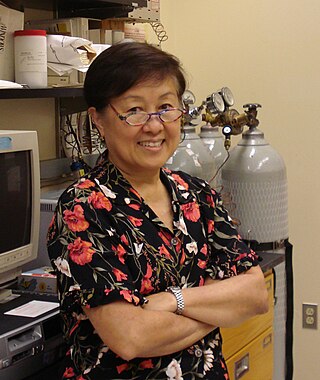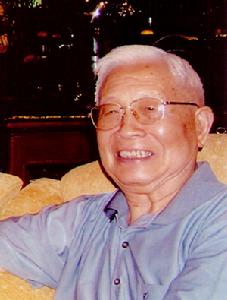Related Research Articles
Methylotrophs are a diverse group of microorganisms that can use reduced one-carbon compounds, such as methanol or methane, as the carbon source for their growth; and multi-carbon compounds that contain no carbon-carbon bonds, such as dimethyl ether and dimethylamine. This group of microorganisms also includes those capable of assimilating reduced one-carbon compounds by way of carbon dioxide using the ribulose bisphosphate pathway. These organisms should not be confused with methanogens which on the contrary produce methane as a by-product from various one-carbon compounds such as carbon dioxide. Some methylotrophs can degrade the greenhouse gas methane, and in this case they are called methanotrophs. The abundance, purity, and low price of methanol compared to commonly used sugars make methylotrophs competent organisms for production of amino acids, vitamins, recombinant proteins, single-cell proteins, co-enzymes and cytochromes.
Methylorubrum extorquens is a Gram-negative bacterium. Methylorubrum species often appear pink, and are classified as pink-pigmented facultative methylotrophs, or PPFMs. The wild type has been known to use both methane and multiple carbon compounds as energy sources. Specifically, M. extorquens has been observed to use primarily methanol and C1 compounds as substrates in their energy cycles. It has been also observed that use lanthanides as a cofactor to increase its methanol dehydrogenase activity
Methylobacillus flagellatus is a species of aerobic bacteria.

Lily Young is a distinguished professor of environmental microbiology at Rutgers New Brunswick. She is also a member of the administrative council at Rutgers University. She is the provost of Rutgers New Brunswick. She is a member of the Biotechnology Center for Agriculture and the Environment and has her academic appointment in the Department of Environmental Sciences.
Angela K. Wilson is an American scientist and former (2022) President of the American Chemical Society. She currently serves as the John A. Hannah Distinguished Professor of Chemistry, associate dean for strategic initiatives in the College of Natural Sciences, and director of the MSU Center for Quantum Computing, Science, and Engineering (MSU-Q) at Michigan State University.

Jillian Fiona Banfield is professor at the University of California, Berkeley with appointments in the Earth Science, Ecosystem Science and Materials Science and Engineering departments. She is the director of microbiology the Innovative Genomics Institute, is affiliated with Lawrence Berkeley National Laboratory and has a position at the University of Melbourne, Australia. Some of her most noted work includes publications on the structure and functioning of microbial communities and the nature, properties and reactivity of nanomaterials.
Laura Lee Kiessling is an American chemist and the Novartis Professor of Chemistry at the Massachusetts Institute of Technology. Kiessling's research focuses on elucidating and exploiting interactions on the cell surface, especially those mediated by proteins binding to carbohydrates. Multivalent protein-carbohydrate interactions play roles in cell-cell recognition and signal transduction. Understanding and manipulating these interactions provides tools to study biological processes and design therapeutic treatments. Kiessling's interdisciplinary research combines organic synthesis, polymer chemistry, structural biology, and molecular and cell biology.

Professor J. S. Chiao, born Jui-Sheng Jiao, was a microbiologist from the Shanghai Institute of Plant Physiology and Ecology of the Chinese Academy of Sciences, and a member of the American Society for Microbiology. Professor Chiao spent 60 years in microbiology research, and was one of the world's leading scientists on its application to the field of biotechnology.

Julia A. Vorholt is a German microbiologist who is a full professor of microbiology at ETH Zurich and an elected member of the German Academy of Sciences Leopoldina.
Kartik Chandran is an American environmental engineer at Columbia University, where he is a professor in the Department of Earth and Environmental Engineering. He primarily works on the interface between environmental molecular and microbiology, environmental biotechnology and environmental engineering. The focus of his research is on elucidating the molecular microbial ecology and metabolic pathways of the microbial nitrogen cycle. Applications of his work have ranged from energy and resource efficient treatment of nitrogen containing wastewater streams, development and implementation of sustainable approaches to sanitation to novel models for resource recovery. Under his stewardship, the directions of biological wastewater treatment and biological nutrient removal were established for the first ever time in the history of Columbia University.
David A. Stahl is an American scientist and Professor of Environmental Engineering. He is best known for the application of molecular microbial ecology to environmental engineering.
E. Virginia Armbrust is a biological oceanographer, professor, and current director of the University of Washington School of Oceanography. She is an elected member of the Washington State Academy of Science, an elected fellow of the American Association for the Advancement of Science, and an elected fellow of the American Academy of Microbiology.
Francis "Frank" J. Doyle III is an American engineer and academic administrator. He is a professor of Engineering and provost of Brown University.
Greg N. Stephanopoulos is an American chemical engineer and the Willard Henry Dow Professor in the department of chemical engineering at the Massachusetts Institute of Technology. He has worked at MIT, Caltech, and the University of Minnesota in the areas of biotechnology, bioinformatics, and metabolic engineering especially in the areas of bioprocessing for biochemical and biofuel production. Stephanopoulos is the author of over 400 scientific publications with more than 35,000 citations as of April 2018. In addition, Greg has supervised more than 70 graduate students and 50 post-docs whose research has led to more than 50 patents. He was elected a fellow of the American Association for the Advancement of Science (2005), a member of the National Academy of Engineering (2003), and received the ENI Prize on Renewable Energy 2011.
Lisa Alvarez-Cohen is the vice provost for academic planning, Fred and Claire Sauer Professor at the University of California, Berkeley. She was elected a member of the National Academy of Engineering in 2010 for the discovery and application of novel microorganisms and biochemical pathways for microbial degradation of environmental contaminants. She is also a Fellow of the American Society for Microbiology.

Abigail A. Salyers was a microbiologist who pioneered the field of human microbiome research. Her work on the bacterial phylum Bacteroidetes and its ecology led to a better understanding of antibiotic resistance and mobile genetic elements. At a time where the prevailing paradigm was focused on E. coli as a model organism, Salyers emphasized the importance of investigating the breadth of microbial diversity. She was one of the first to conceptualize the human body as a microbial ecosystem. Over the course of her 40-year career, she was presented with numerous awards for teaching and research and an honorary degree from ETH Zurich, and served as president of the American Society for Microbiology.
Ann Patricia Wood is a retired British biochemist and bacteriologist who specialized in the ecology, taxonomy and physiology of sulfur-oxidizing chemolithoautotrophic bacteria and how methylotrophic bacteria play a role in the degradation of odour causing compounds in the human mouth, vagina and skin. The bacterial genus Annwoodia was named to honor her contributions to microbial research in 2017.

John Rodney (Rod) Quayle FRS (1926–2006) was a microbial biochemist, West Riding Professor of Microbiology and Head of Department at University of Sheffield (1965–1983) and then Vice-Chancellor of Bath University (1983–1992). He adopted techniques for dissecting enzymic reactions using radioactive carbon-14. He focused on microbes that used compounds containing one atom of carbon as their sources of energy and biomass.
Formatotrophs are organisms that can assimilate formate or formic acid to use as a carbon source or for reducing power. Some authors classify formatotrophs as one of the five trophic groups of methanogens, which also include hydrogenotrophs, acetotrophs, methylotrophs, and alcoholotrophs. Formatotrophs have garnered attention for applications in biotechnology as part of a "formate bioeconomy" in which synthesized formate could be used as a nutrient for microoganisms. Formate can be electrochemically synthesized from CO2 and renewable energy, and formatotrophs may be genetically modified to enhance production of biochemical products to be used as biofuels. Technical limitations in culturing formatotrophs have limited the discovery of natural formatotrophs and impeded research on their formate-metabolizing enzymes, which are of interest for applications in carbon sequestration and astrobiology.
Joseph Mougous is an American microbiologist. He is a Professor of Microbiology, the Lynn M. and Michael D. Garvey Endowed Chair in Gastroenterology, the Director of the Microbial Interactions & Microbiome Center, and a Howard Hughes Medical Institute Investigator at the University of Washington. Mougous is best known for contributions to the field interbacterial antagonism, including discovering the antibacterial activity of the Type VI secretion system (T6SS).
References
- 1 2 3 "Mary E. Lidstrom". UW Chemical Engineering. Retrieved 2022-03-02.
- 1 2 "Member Directory: Mary E. Lidstrom". National Academy of Sciences.
- ↑ Chistoserdova, Ludmila; Kalyuzhnaya, Marina G.; Lidstrom, Mary E. (2009). "The Expanding World of Methylotrophic Metabolism". Annual Review of Microbiology. 63: 477–499. doi:10.1146/annurev.micro.091208.073600. PMC 2827926 . PMID 19514844.
- ↑ O'Connor, Mary Lidstrom (1977). The regulation of C-1 metabolism in Methylobacterium organophilum. Madison, Wis.: University of Wisconsin. OCLC 609162422.
- ↑ Anthony, Christopher (2015). "JOHN RODNEY QUAYLE 18 November 1926 — 26 February 2006". Biogr. Mem. Fellows R. Soc. 61: 331–349. doi: 10.1098/rsbm.2015.0008 . S2CID 88245387.
- 1 2 3 "Mary E. Lidstrom, Ph.D. CURRICULUM VITAE Education (formerly Mary L. O'Connor)". StudyLib. Retrieved 6 May 2022.
- ↑ "Mary Lidstrom". University of Washington.
- ↑ Holtz, Jackson. "Mari Ostendorf named UW Vice Provost for Research". University of Washington. Retrieved 10 July 2021.
- ↑ "Six AAAS Members Win American Society for Microbiology Award | American Association for the Advancement of Science". www.aaas.org. Retrieved 2022-03-02.
- ↑ "Mary E. Lidstrom". www.nasonline.org. Retrieved 2022-03-02.
- 1 2 "Awards and Recognition". UW ADVANCE. 2010-11-12. Retrieved 2022-03-02.
- ↑ "10 UW profs honored as Fellows of AAAS". UW News. Retrieved 2022-03-02.